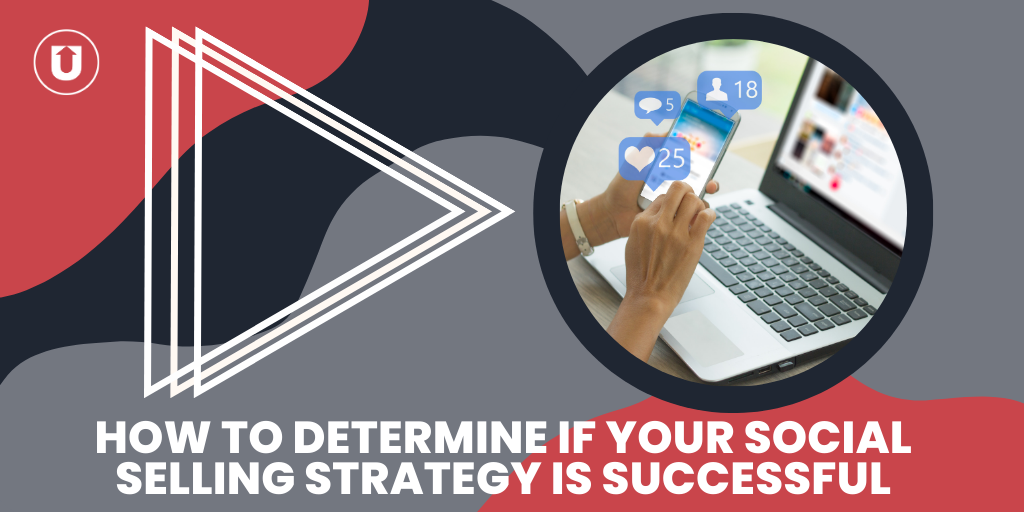How To Determine If Your Social Selling Strategy Is Successful

Sales and marketing have the same goal in any company: to grow the business in a sustainable way.
If you boil it down to the simplest terms, both need to generate more of the right leads and turn those leads into happy, loyal customers.
If trust is a strong driver of your clients’ and customers’ decision-making, one of the most efficient and effective strategies for accomplishing your mutual goals is “social selling,” the process of connecting with prospects and building relationships with them via social media.
And it pays off: Social selling programs drive increased pipeline, better win rates, and up to 48% larger deals.
Plus, when a lead is generated through social selling, it’s seven times more likely to close.
In order to succeed, you must recognize that an effective social selling strategy will achieve marketing and sales departmental goals in a frictionless and mutually supportive way - no grappling over resources or divergent pathways to success over here!
But what is a successful social selling strategy? How do you know if your team is set up for success?
Here at UpContent, we have worked with hundreds of companies to create a seamless and near-fully automated social selling strategy (here is why you shouldn’t automate everything), and we have found three common characteristics that are critical to success.
In this article, we’ll talk about the importance of (1) getting your team actively and habitually engaged in social selling, (2) ensuring you’re giving credit where credit is due, and (3) the best way to treat your sales reps to get the most from what they share with their personal networks.
Your Team Is Actively Engaging In Social Selling
Successful social selling begins with aligning expectations on what success truly means.
Just like your website will never convert 100% of its visitors, striving to achieve 100% adoption and consistent engagement across your team shouldn’t be a litmus test for success.
Let’s break down what success should look like by segmenting who likely makes up your sales team.
When you look at an average sales team, usually you’ve got three distinct areas on that team.
#1: You’ve got top performers, usually a smaller percentage of your overall team, who do everything well. They’ve got their system. They’re making it happen.
#2: Then you’ve got your lackluster team members who probably aren’t going to be around much longer. They often make up an equally small percentage of your team.
While you can see marginal improvement in both of these first two groups, they only compose a collective 10-20% of your overall team and generally aren’t going to change habits.
Your social selling program isn’t really designed for them. It’s for the third group, which normally makes up about 80% of your sales team.
#3: The middle-of-the-pack group are your employees who will benefit most from a social selling strategy. They are the ones who are trying to get to the top but need some help getting there.
Maybe they are newer to the organization, to sales, to the industry (or all three).
They could be working on translating their successful in-person tactics to the digital landscape — or simply in the process of honing their craft — and are looking for the supporting infrastructure to really propel them into that top group.
A successful social selling strategy should incite adoption and engagement amongst this group, helping them climb up into that top performer category and showcase how activity within the program helps them achieve and retain this top-performer status.
Success happens when sharing content becomes a habit for your team.
Focusing on the “middle of the pack” allows you to customize the content that’s shared and ensure that your salespeople’s workflow is seamless so results can be measured.
The right adoption rate can vary based on the size of your team, but you have to make it as easy as possible for your team to adopt your social selling process.
You Give Lead Credit To The Right People
Once you’ve got your sales team on board and you’re building good content-sharing habits, you need to be able to analyze the impact and make sure that your reps are seeing direct benefits from any leads that they’ve created through the program.
After all, 54% of salespeople who use social media can track their social media usage back to at least one closed deal. And you can’t ask them to start social selling and then hoard all the leads as a marketing team.
Whether your structure has your sales reps working their leads individually or if there is another group that will qualify those opportunities, the leads they create from social selling need to be attributed to them.
There must be some sort of recognition or association between the lead and the individual that generated it because that reinforces those good habits and gets them to want to double down on their own social selling and thought leadership efforts.
This doesn’t mean that every post shared should be expected to convert.
In fact, a proper mix of content includes a majority of posts where conversion is not the primary goal.
"Content mix matters. If you want to arm your sellers to be successful, give them content that resonates with the accounts they are targeting. It's not a one-size-fits-all scenario,” EveryoneSocial’s CRO Chris Reese says.
“Take the time to really understand what matters to your sellers' target audiences and build to that. The trade-offs of potentially having more niche-focused content vs. large ‘spray and pray’ pieces will be in closed won dollars. You’ll see the value.”
.png?width=388&height=485&name=AI%20cant%20replace%20original%20thought%2c%20whether%20you%E2%80%99re%20using%20it%20for%20content%20creation%20or%20curation%2c%20but%20it%20can%20do%20all%20the%20other%20heavy%20lifting.%20(2).png)
Just like today’s sales process, which requires a number of touchpoints prior to a prospect’s decision, the intention of social selling is to be consistently present with valuable insights in a way that builds credibility amongst a growing network of active audience members.
It is through this effort that when a member of your immediate or extended network has a need that you can help solve, you become whom they contact first — and perhaps more importantly, whom they feel comfortable moving more quickly through the process with, given the credibility you have earned.
You Treat Your Sales Reps As Customers, Not Conduits
If you’re treating your sales team as conduits for your company-created content and just see them as a pathway to their audience, then you have missed the point of social selling.
Instead, you should treat your sales team like you do your customers.
Is the content you are providing them with valuable? Does social selling benefit them and their thought leadership?
If given the choice, would your team elect to “renew” the program for another year, or do they feel “required” to participate?
We see social selling programs fail when they become merely another way to push company-created content and then drive those leads back to the company site rather than focusing on enabling each individual salesperson to build their personal brand in a way that benefits them first and, through that benefit, the organization.
How To Treat Your Team As Customers, Not Conduits
So if you treat your sales team as a conduit but want to shift gears to make your social selling strategy work, where do you start?
#1: Don’t force them to share
Don’t be that person who says, “Everyone, stop what you’re doing and share this article today.”
Nobody likes being told what to do, and chances are there isn’t going to be an article that every single person on your team is going to think is valuable to their audience.
Social selling is about establishing credibility and developing an individual personal brand — and that requires authentic sharing.
What’s worse- If your team does follow your instruction, having a cluster of people share the exact same thing in the exact same way does very little to help them become better understood by their audience. Who does this serve?
You have to trust that your team is capable of great things when given the right tools and training.
They know what they want to share with their audience, and all they need is the support to ensure they can easily find the content that best conveys their expertise and personal brand - and stimulates their network to act.
#2:Don’t make it super complicated
Sending a random email out of the blue asking people to share some content is, very rarely, if ever, going to work.
Not everyone is going to open their email; you’re doing well if they read the subject line.
But then they have to open the email, click on the link, find something to say about it, copy and paste the URL into their post, and write something.
That’s so many steps that aren’t easy to replicate and create a habit with.
Find a content-sharing process with as few steps as possible to build the habit of sharing good content without being prompted to.
Consistency is critical in a successful social selling effort.
#3: Create a feedback loop
Share the results of your team’s efforts. Highlight what’s working and what’s not, and ask them how to make the program easier and better for them.
This is a great opportunity for continuous learning — and we know that 53% of salespeople want help in understanding social selling better.
Do all those things and do them well, and your sales team will see the effort as a benefit to them for being a part of your organization and an easier pathway to consistently achieve their professional goals.
Your business will grow, your “middle of the pack” will see an average performance increase, and your top performers will be more likely to stay with your organization because they know they won’t see the same level of support if they go somewhere else.
In the end, if you don’t try to treat your salespeople like conduits for your corporate messaging, you’re going to see success with social selling through not only a more satisfied and motivated sales team but also better-qualified leads.
Next Steps To Creating Your Successful Social Selling Strategy
If you take anything from this article, it’s this: make social selling a habit that your team wants to form.
“Sellers need to be where their buyers are, and in today's world, those buyers are on social,” Chris says.
“There is no better place to be seen, engage and start sales conversations than directly on social networks. If a seller wants to be successful in todays sales world, they need to be social. There is no alternative,” he adds.
Give your sales team an easy workflow that makes sharing the content they want to share something that’s simple, turning into a consistent (at least weekly) habit.
How do you keep your team coming back to participate?
Always have fresh, engaging, valuable content ready for them to share.
If a team member checks in on Monday and sees some great stuff, and then they come back on Thursday, and it’s the same stuff they saw on Monday, coming back to it the next Monday is infinitely harder than it was to get them to first log in on that first Monday.
Now you have to convince them that the program is worth their time and have broken a good habit that hardly formed.
What is the best way to do this? Ensure a consistent volume of diverse and quality third-party and original content is available for them to share.
UpContent was created to solve for just that!
You can create custom Topics and Collections that provide the custom-filtered third-party articles your sales team demands to make your social selling program their go-to source for articles they want to read and share.
What’s better? UpContent already integrates into the social selling platform your team is using (whether as robust as Everyone Social or as simple as sending messages via a Slack channel or internal email campaign).
If you’re ready to create or change your current social selling strategy into a successful one, schedule a call with one of our Content Curation Experts, who can help you establish the simplest and habit-forming social selling process you need.
If you’d like to learn more about social selling and how curated content can help, check out some of these articles:
Why Your Social Selling Strategy Isn’t Working, and How You Can Fix It
Social Selling and Employee Advocacy Platforms That Integrate with UpContent



